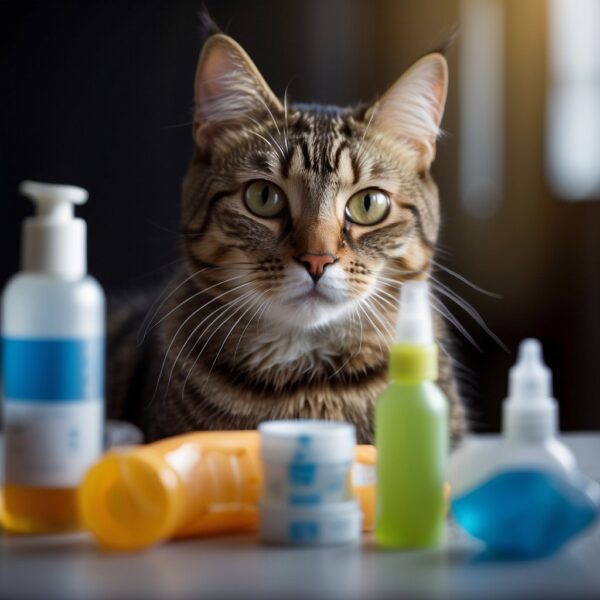
Cat Allergies: An Overview
Cats, like humans, can indeed suffer from allergies. These allergic reactions are the result of the immune system’s hypersensitivity to foreign substances, which can range from proteins in their food to environmental factors like pollen or dust mites. Allergies in cats can cause a variety of symptoms that can affect their skin, respiratory system, and overall well-being. Understanding the range and nature of these allergic reactions is crucial for responsible cat parents.
Notably, the signs of allergies in cats can be subtle or pronounced, depending on the severity of the reaction. The most common symptoms include skin irritation, itching, and respiratory issues such as sneezing or wheezing. Since these symptoms can also be indicative of other health issues, it’s important for cat parents to seek a professional diagnosis. The appropriate treatment and management of allergies depend on the type and cause of the allergic reaction, which can often be identified through various tests conducted by a veterinarian.
Key Takeaways
- Cats can experience allergic reactions to various substances, similar to humans.
- Symptoms can range from skin irritations to respiratory issues, requiring attentive care.
- Proper diagnosis, treatment, and management are essential for a cat’s health and comfort.

Understanding Cat Allergies
Cat allergies are a prevalent condition where an over-reactive immune system causes discomfort and health issues. This section explores the nature and causes of allergies in felines, along with the specifics of allergic reactions.
What Are Allergies in Cats
Allergies in cats occur when their immune system mistakenly identifies a typically harmless substance as a threat. This results in an overreaction that causes symptoms such as itching, sneezing, and skin irritations. Cats can develop several types of allergies, including those to food, environmental factors, and parasites.
Common Types of cat Allergens
Cats can be allergic to a variety of substances, including but not limited to:
- Environmental allergens: pollen, mold, and dust mites
- Parasitic allergens: primarily flea saliva
- Contact allergens: household cleaners, plastic, and certain fabrics
- Food allergens: usually proteins from beef, dairy, and chicken
Allergic Reaction Mechanism in Cats
When a cat comes into contact with an allergen, their immune system may overreact by producing antibodies. This immune response can lead to inflammation and a range of symptoms affecting the cat’s skin and respiratory system. The extent of this reaction varies greatly among individual cats and can depend on the type and amount of exposure to the allergen.
Symptoms of Allergies in Cats
Cats with allergies exhibit various symptoms affecting their respiratory system, skin, and gastrointestinal tract. These symptoms can range in severity and often necessitate veterinary attention for proper management.
Respiratory and Skin Manifestations
- Respiratory Symptoms:
- Sneezing
- Coughing
- Wheezing
- Stuffy or runny nose
Cats may display respiratory symptoms such as sneezing, coughing, and wheezing. A runny or stuffy nose can also occur, indicative of irritation in the nasal passages.
- Skin Symptoms:
- Itching: Persistent scratching, often leading to more severe skin conditions.
- Redness: Visible irritation and inflammation of the skin.
- Rash: Miliary dermatitis can manifest as rash-like, scabby lesions.
- Hair Loss: Allergic reactions may cause cats to lose hair in affected areas.
- Scabs: As a consequence of scratching, scabs may form, particularly along the back and neck.
- Licking: Excessive grooming or licking is a sign of itchy skin.
The skin is another target for allergic reactions in cats. Symptoms include persistent itching that can lead to redness, rashes, hair loss, and the formation of scabs. Cats may excessively lick or over-groom themselves, a behavior that is often associated with allergic itchiness.
Gastrointestinal Symptoms
- Vomiting: An immediate reaction to allergens present in food.
- Diarrhea: May occur alongside vomiting as part of an allergic response.
When cats suffer from food allergies, they can experience gastrointestinal upset, which typically presents as vomiting and diarrhea. These symptoms can arise if a cat ingests substances to which it is allergic.

Diagnosing Allergies in Cats
When a cat displays symptoms suggesting an allergic reaction, a thorough process to accurately pinpoint the cause is crucial. This typically involves a combination of veterinary consultation and specific allergy testing.
Consulting a Veterinarian about your cat’s allergies
The first step in diagnosing allergies in felines is a comprehensive evaluation by a veterinarian. Veterinarians review the cat’s medical history and conduct a full physical examination. Vital to this process is the differentiation between allergies and other conditions with similar symptoms, which may include infection or parasitic infestations. The veterinarian may also inquire about the cat’s environment, diet, and any recent changes that could correlate with the onset of symptoms.
Skin and Blood Testing
After initial assessments, vets may recommend specific allergy tests:
- Skin Test (Intradermal Skin Test): Small amounts of allergens are injected under the cat’s skin to observe reactions. This test specifically helps in identifying environmental allergens such as pollen, mold, and dust.
- Blood Test: A blood sample from the cat can be analyzed for antibodies to different allergens, indicating a potential allergic response. However, blood tests may not be as sensitive as skin tests for certain types of allergies.
Both skin tests and blood tests aim to identify the allergens responsible for triggering the cat’s immune response. It’s important to note that while these tests are helpful, they require interpretation by a skilled veterinarian to diagnose allergies accurately.
Treatment Options for Cats with Allergies

Effective management of allergies in cats involves a combination of medical treatments and environmental adjustments to alleviate symptoms and improve quality of life.
Cats with Allergies: Medication and Supplements
Cats with allergies may require medication to control symptoms. Antihistamines are commonly used to reduce itching and other allergic reactions by blocking histamine, the substance that causes these symptoms in response to an allergen. For more severe cases, corticosteroids can be prescribed to reduce inflammation. However, long-term use of steroids can have significant side effects, so veterinarians typically regulate them carefully.
Supplementing a cat’s diet with fatty acids may help improve skin health and reduce allergic reactions. In addition, cyclosporine, a drug that alters the immune system’s response, can be effective for treating skin allergies in cats. The approach to medication should be tailored for each cat by the veterinarian, and a comprehensive treatment plan should be developed.
Immunotherapy and Lifestyle Changes
For long-term allergy treatment, immunotherapy, commonly known as allergy shots, may be considered. This involves injecting small amounts of the allergen into the cat’s system in gradually increasing doses to desensitize the immune system. Immunotherapy is a commitment as it may take months to see improvement, but it can lead to a significant reduction in allergy symptoms over time.
Environmental controls and lifestyle changes play a crucial role in managing allergies. Reducing exposure to the identified allergens—such as fleas, certain foods, or dust mites—can drastically decrease allergic reactions. For instance, frequent vacuuming, using hypoallergenic bedding, or feeding hypoallergenic diets are practical steps that may be recommended as part of the treatment plan. These adjustments, made with a veterinarian’s guidance, can complement medical treatments to improve the cat’s condition.
Managing Environmental and Food Allergies
Cats with allergies require careful management that includes recognizing and avoiding specific allergens and making appropriate dietary adjustments. Success lies in the details, such as controlling exposure to environmental particles and tailoring the cat’s diet to mitigate reactions.
Identifying and Avoiding Allergens
Identifying environmental allergens such as pollen, dust mites, mold, and flea saliva is critical for managing a cat’s allergies. Common strategies include:
- Regular Grooming: By bathing a cat with hypoallergenic shampoos, owners can remove accumulated dander and pollen from the cat’s coat.
- Home Environment Control: Utilizing HEPA filters, frequent vacuuming of rugs and furniture, and using dust-free cat litter can minimize exposure to dust and mold spores.
- Avoidance of Smoke and Chemicals: Ensuring the cat’s environment is free from cigarette smoke, chemicals, and strong detergents is essential as these can exacerbate allergic reactions.
Dietary Adjustments
When it comes to food allergies in cats, precise dietary management can help alleviate symptoms. This often includes:
- Hypoallergenic Diet: Introducing a hypoallergenic diet or novel protein sources, such as duck or venison, which the cat has not been exposed to previously, to avoid triggering a food allergy.
- Elimination Diet: Implement carefully monitored elimination diets to pinpoint specific food allergens like beef, chicken, or fish. During this period, grains and other common allergenic ingredients should be avoided.
In summary, mitigating the effects of both environmental and food allergies in cats involves a combination of environmental controls and keen dietary management. With vigilance and adaptation, owners can create a more comfortable environment for their cats.
Preventing Allergic Reactions
Preventing allergic reactions in cats involves meticulous cleaning to reduce potential allergens and proactive flea control measures. Owners must establish a clean environment and regular pet care routines to minimize the risk of allergy flare-ups.
Regular Cleaning and Flea Prevention
Regular cleaning is essential in preventing allergen accumulation, which can trigger allergic reactions in cats. Guardians should focus on:
- Vacuuming: Using a vacuum cleaner with a HEPA filter at least once a week can significantly reduce the presence of allergens such as dust mites and pet dander in carpets and upholstery.
- Flea Control: Flea allergy dermatitis, caused by an allergic reaction to flea saliva, is a common condition in cats. Effective flea control routines often include:
- Topical Flea Treatments: Monthly applications can help prevent flea infestations.
- Oral Medications: Some cats may require oral flea prevention options.
Home Remedies: If a cat shows mild reactions, bathing them with a gentle hypoallergenic shampoo can help soothe skin and remove allergens from the fur.
Allergy-Proofing Your Home
To further protect cats from allergic reactions, owners can allergy-proof their home:
- Choose the Right Detergents: Hypoallergenic detergents for washing cat bedding can reduce the risk of contact allergies.
- Maintaining Clean Furniture: Regularly wiping down surfaces and washing throws can limit exposure to potential allergens.
Allergy-proofing a home requires consistent effort, but it can significantly improve the quality of life for cats with allergies.
Complications and Comorbid Conditions
Cats with allergies often experience various complications that can significantly affect their quality of life. In particular, respiratory complications and skin or ear infections are common comorbid conditions arising from allergic reactions. These issues require prompt attention to prevent further deterioration of a cat’s health.
Respiratory Complications
Cats may develop asthma or other respiratory problems as a result of allergies. Symptoms can include wheezing, coughing, sneezing, and difficulty breathing. For cats, respiratory complications can escalate quickly and may manifest after exposure to allergens such as pollen, dust, or smoke. It is critical to observe any changes in breathing and seek veterinary care if these symptoms occur.
Skin and Ear Infections
Allergic reactions in cats can often lead to skin infections, including bacterial skin infections, due to excessive scratching and damage to the skin barrier. Signs to look for include:
- Redness
- Swelling
- Oozing from sores
Similarly, ear infections in cats may accompany or result from allergies. Indicators of ear infections might be:
- Persistent scratching at the ears
- Head shaking
- Foul odor from the ears
Skin and ear infections require veterinary treatment, which may involve antibiotics or antifungal medications depending on the underlying cause. Regular monitoring and maintaining a clean environment can help manage symptoms and prevent recurrence.
Following a Long-Term Management Plan
Effective long-term management of feline allergies involves consistent veterinary care and active monitoring of the cat’s condition, with the flexibility to adapt the management strategy as needed.
Consistent Veterinary Care
Regular check-ups with a veterinarian are crucial for cats with allergies. A veterinarian can help track the progress of your cat’s allergies and adjust the treatment plan accordingly. This may include administering medications such as antihistamines, corticosteroids, or other anti-inflammatory drugs to control symptoms. In cases of chronic conditions like atopic dermatitis, immunotherapy may be recommended as a long-term treatment option.
Monitoring and Adapting the Management Strategy
Cat parents should observe their cats closely for changes in symptoms and potential new allergen exposures. Since allergy treatment can be an evolving process, adjustments to the treatment plan—such as changing medications, adding supplements, or altering doses—are often necessary. It is important to keep a detailed log of your cat’s allergy symptoms and response to treatments to discuss with the veterinarian during follow-up visits.

Frequently Asked Questions
Navigating the realm of feline allergies can lead to many questions. This section aims to demystify some of the more commonly asked queries regarding how one can identify, manage, and understand allergies in cats.
How can you identify allergies in cats?
One can identify allergies in cats by noting changes in their behavior or physical condition that are symptomatic of an allergic reaction, such as excessive grooming or changes in their skin.
What are common symptoms of allergies in cats?
Common symptoms include skin irritation, scratching, and grooming excessively. Respiratory symptoms may occur but are less common and include sneezing or coughing.
What substances are cats most often allergic to?
Cats are most often allergic to fleas, pollen, dust, molds, certain foods, and in some cases, materials they come into contact with, such as synthetic fibers.
How are respiratory allergies manifested in cats?
Respiratory allergies in cats are manifested through symptoms like coughing, wheezing, and in some instances, nasal or ocular discharge.
What are the natural remedies for feline allergies?
Natural remedies can include omega-3 fatty acid supplements to aid in skin health, as well as bathing the cat with hypoallergenic shampoos to relieve skin irritation.
Is it possible for indoor cats to develop allergies?
Indoor cats can develop allergies, as allergens, such as dust, mold spores, or household chemicals, are not exclusive to outdoor environments.